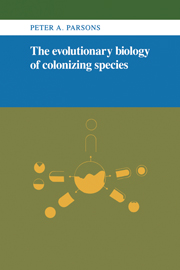Book contents
- Frontmatter
- Contents
- Preface
- 1 Introduction: Colonists and habitats
- 2 Genetics and ecology
- 3 Physical conditions, resources, and ecological phenotypes
- 4 Variability in natural populations
- 5 Genetic variability, ecological phenotypes, and stressful environments
- 6 Colonizing phenotypes and genotypes
- 7 Behavioral variability in natural populations
- 8 Habitat selection
- 9 The ecobehavioral phenotype: generalists and specialists
- 10 The ecobehavioral phenotype: biological control and domestication
- 11 Parasites and plants
- 12 Discussion and conclusions
- Appendix The study of quantitative traits
- References
- Index
4 - Variability in natural populations
Published online by Cambridge University Press: 15 September 2009
- Frontmatter
- Contents
- Preface
- 1 Introduction: Colonists and habitats
- 2 Genetics and ecology
- 3 Physical conditions, resources, and ecological phenotypes
- 4 Variability in natural populations
- 5 Genetic variability, ecological phenotypes, and stressful environments
- 6 Colonizing phenotypes and genotypes
- 7 Behavioral variability in natural populations
- 8 Habitat selection
- 9 The ecobehavioral phenotype: generalists and specialists
- 10 The ecobehavioral phenotype: biological control and domestication
- 11 Parasites and plants
- 12 Discussion and conclusions
- Appendix The study of quantitative traits
- References
- Index
Summary
Natural selection which guides evolutionary change acts primarily on phenotypes, and only secondarily on genotypes.
[Waddington, 1965:1]In the last chapter, variation was mainly considered at the interspecific level. Ecological phenotypes important in determining the distribution and abundance of organisms were demonstrated. For genetic analysis, phenotypic variation must be considered at the intraspecific level. Accordingly, in this chapter, variability in natural populations will be discussed, together with comments on the analysis of such variability.
Morphology and climate-related variation
Geographical clines exist for morphological characters in widespread Drosophila species. A thorough study has been conducted on D. robusta, a mainly woodland species, which occurs in eastern North America, extending from southern Canada in the north to the Gulf of Mexico in the south and as far west as Nebraska. Stalker and Carson (1947, 1948, 1949) have studied geographical, altitudinal, and seasonal variation in body size. The geographical study compared 45 strains collected from 22 widely separated localities for the morphological measurements of thorax length, head width, femur length, wing width, and wing length. Significant differences were found between strains derived from the same locality, but the major variation in the data is clearly among populations (Figure 4.1). There is a strong correlation between average annual temperature and body size estimated from a compound measurement including all five measurements using the discriminant function approach of Fisher (1936). Accordingly, there is a well-developed geographical north–south cline in morphology, with body size increasing as the average annual temperature decreases.
- Type
- Chapter
- Information
- The Evolutionary Biology of Colonizing Species , pp. 43 - 62Publisher: Cambridge University PressPrint publication year: 1983



